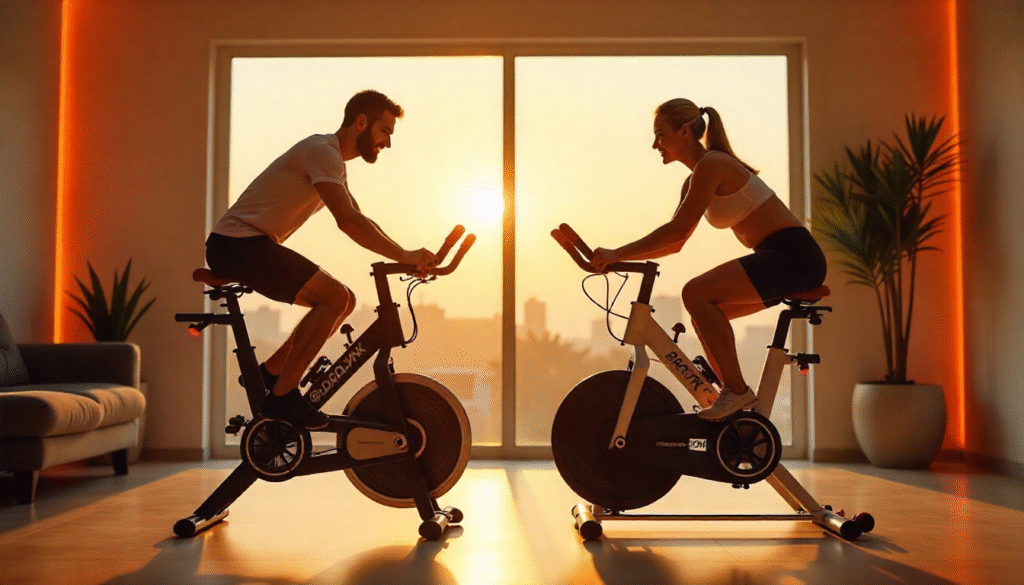The Best Fluffy Pancakes recipe you will fall in love with. Full of tips and tricks to help you make the best pancakes.
Spin Bike vs Exercise Bike: What Should You Buy?

Imagine this: you’re finally ready to turn that corner of your living room into your personal fitness haven. You’ve got your playlist queued, your water bottle filled, and your motivation high—but there’s just one decision standing in your way. Spin bike or exercise bike? It seems simple until you’re hit with dozens of specs, styles, and options.
This blog post breaks down every essential difference between spin bikes and exercise bikes to help you make an informed, confident decision. Whether you’re a weekend warrior chasing HIIT goals or someone simply looking to move more during the week, choosing the right indoor cycling setup can completely redefine your fitness journey.
We’ve compared these two bike types across riding posture, resistance systems, workout intensity, adjustability, and their overall training purpose. Ready to find your perfect match? Let’s spin through the facts.
Riding Position: Finding Your Perfect Indoor Cycling Stance
The riding position on your spin bike versus an exercise bike creates completely different indoor cycling experiences that cater to distinct fitness goals. Spin bikes position you in an aggressive, forward-leaning posture that mimics a road bike, engaging your core and creating that authentic cycling feel that serious riders crave. This position allows for standing climbs, sprints, and the dynamic movements that make indoor cycling classes so engaging and effective. Exercise bikes, on the other hand, place you in an upright, relaxed position with higher handlebars that feels more like sitting in a comfortable chair while pedaling.
• Spin Bike Advantage: Forward-leaning position engages core muscles and allows for varied riding positions during indoor cycling workouts.
• Exercise Bike Comfort: Upright posture reduces strain on back and neck, making it ideal for longer, leisurely rides.
• Core Engagement: Spin bike positioning naturally activates stabilizing muscles throughout your torso during intense sessions.
• Versatility Factor: Aggressive positioning on spin bikes enables standing climbs and sprint intervals that maximize calorie burn.
Flywheel and Resistance: The Power Behind Your Pedal Stroke
The engineering differences between spin bikes and exercise bikes become most apparent when examining their flywheel and resistance systems, which directly impact your indoor cycling experience and workout quality.
| Feature | Spin Bike | Exercise Bike |
| Flywheel Weight | Heavy flywheel (13-20+ kg), momentum-based smooth pedaling | Lighter flywheel (under 10 kg), more assisted and choppy feel |
| Resistance System | Manual or magnetic; often friction-based with infinite adjustment | Usually magnetic and electronically controlled with preset levels |
| Pedal Feel | Natural, road-like momentum that carries through dead spots | More assisted feeling with less authentic cycling experience |
| Maintenance | May require occasional pad replacement if friction-based | Typically maintenance-free with electronic systems |
The heavier flywheel on spin bikes creates that authentic road bike feeling where momentum carries you through each pedal stroke, while exercise bikes rely more on electronic assistance that can feel artificial to experienced cyclists.
Workout Intensity and Calorie Burn: Maximizing Your Fitness Results
When it comes to crushing calories and building serious fitness, spin bikes and exercise bikes operate in completely different intensity leagues. Spin bikes excel at high-intensity interval training, allowing you to incorporate sprints, climbs, and varied resistance that can torch 400-700 calories in a 45-minute session. The aggressive positioning and heavy flywheel enable you to generate serious power output during indoor cycling workouts that rival outdoor training sessions. Exercise bikes, while excellent for steady-state cardio, typically cap out at lower intensity levels that burn fewer calories per session.
• HIIT Capability: Spin bikes handle intense interval training with standing climbs and sprint intervals that maximize calorie burn.
• Power Generation: Heavy flywheel systems allow for higher wattage output during peak efforts in indoor cycling sessions.
• Training Variety: Spin bikes accommodate diverse workout styles from endurance rides to explosive sprint sessions.
• Calorie Efficiency: Higher intensity potential means more calories burned per minute compared to traditional exercise bikes.
Adjustability and Ergonomics: Customizing Your Perfect Fit
The adjustability features between spin bikes and exercise bikes reveal a stark contrast in their approach to user customization and indoor cycling comfort. This comparison shows why serious cyclists gravitate toward spin bike versatility:
| Feature | Spin Bike | Exercise Bike |
| Saddle Adjustment | Height + fore/aft positioning for perfect leg extension | Usually height-only adjustment limits optimal positioning |
| Handlebar Adjustment | Height + fore/aft for personalized reach and comfort | Fixed or limited height adjustment only |
| User Accommodation | Fits riders from 5’0″ to 6’5″ with proper adjustments | Limited range may not accommodate all body types |
| Multi-User Friendly | Quick adjustments allow multiple users optimal fit | Compromised positioning for different user heights |
Spin bikes offer the comprehensive adjustability needed for proper bike fit, while exercise bikes often force users to adapt to limited positioning options that may cause discomfort during longer indoor cycling sessions.
Training Purpose: Matching Your Equipment to Your Goals
Your fitness goals should drive your choice between spin bikes and exercise bikes, as each serves distinctly different training purposes in the indoor cycling world. Spin bikes cater to serious cyclists, competitive athletes, and fitness enthusiasts who want structured, performance-driven workouts that simulate outdoor riding conditions. They’re perfect for following structured training plans, connecting to apps, and pushing your limits with high-intensity sessions. Exercise bikes serve the general fitness market better, offering comfortable, low-impact cardio that’s ideal for rehabilitation, casual fitness, and steady-state endurance building.
• Performance Training: Spin bikes excel for cyclists wanting to maintain or improve outdoor riding fitness during indoor sessions.
• App Compatibility: Most spin bikes integrate seamlessly with virtual training platforms and structured workout programs.
• Competitive Edge: Serious athletes choose spin bikes for their ability to replicate race-like efforts and training intensities.
• Rehabilitation Focus: Exercise bikes provide gentler, more supportive indoor cycling options for injury recovery and low-impact fitness.
Summary
Choosing between a spin bike and an exercise bike really comes down to what kind of rider you are—or want to become. If you’re hungry for performance, sweat-driven workouts, and that road-cycling feel, the spin bike will be your ride-or-die companion. With a heavier flywheel, aggressive posture, and infinite resistance, it’s built for power, calorie burn, and progress.
On the flip side, if your priority is comfort, joint protection, or you’re easing into a fitness routine, the exercise bike offers a safer and more relaxing ride. Its upright frame, electronic resistance, and low-impact design make it perfect for beginners or anyone focused on steady-state endurance.
By the end of this guide, one thing is clear: your goals are the compass. Choose the bike that aligns with your vision of health, and your indoor cycling journey will become not just effective—but truly enjoyable.Check our latest posts about What To Eat Before Spin Class and How To Prevent Injuries
Frequently Asked Questions (FAQs)
A spin bike is far better suited for high-intensity training thanks to its heavy flywheel, standing sprint capabilities, and advanced resistance options.
Yes, due to their ability to handle high-intensity intervals and standing climbs, spin bikes can burn significantly more calories per session.
Spin bikes offer more detailed adjustability (saddle and handlebars), making them more suitable for households with multiple users of different heights.
Exercise bikes are better for rehabilitation as they provide a stable, upright posture and lower-intensity, low-impact cardio.





